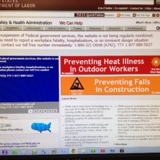Information
-
Audit Title
-
Client / Site
-
Conducted on
-
Prepared by
-
Location
-
Personnel
14.0 Portable Ladders
-
14.1 Are all ladders maintained in good condition, joints between steps and side rails tight, all hardware and fittings securely attached, and moveable parts operating freely without binding or undue play?<br>
-
14.2 Are non-slip safety feet provided on each metal or rung ladder, and are ladder rungs and steps free of grease and oil?<br>
-
14.3 Are employees prohibited from placing a ladder in front of doors opening toward the ladder unless the door is blocked open, locked, or guarded?<br>
-
14.4 Are employees prohibited from placing ladders on boxes, barrels, or other unstable bases to obtain additional height?<br>
-
14.5 Are employees required to face the ladder when ascending or descending?<br>
-
14.6 Are employees prohibited from using ladders that are broken, have missing steps, rungs, or cleats, broken side rails, or other faulty equipment?<br>
-
14.7 Are employees instructed not to use the top step of ordinary stepladders as a step?<br>
-
14.8 When portable rung ladders are used to gain access to elevated platforms, roofs, etc., does the ladder always extend at least 3 feet (0.9144 meters) above the elevated surface?<br>
-
14.9 Are employees required to secure the base of a portable rung or cleat type ladder to prevent slipping, or otherwise lash or hold it in place?<br>
-
14.10 Are portable metal ladders legibly marked with signs reading "CAUTION - Do Not Use Around Electrical Equipment" or equivalent wording?<br>
-
14.11 Are employees prohibited from using ladders as guys, braces, skids, gin poles, or for other than their intended purposes?<br>
-
14.12 Are employees instructed to only adjust extension ladders while standing at a base (not while standing on the ladder or from a position above the ladder)?<br>
-
14.13 Are metal ladders inspected for damage?<br>
-
14.14 Are the rungs of ladders uniformly spaced at 12 inches (30.48 centimeters) center to center?<br>
19.0 Machine Guarding
-
19.1 Is there a training program to instruct employees on safe methods of machine operation?<br>
-
19.2 Is there adequate supervision to ensure that employees are following safe machine operating procedures?<br>
-
19.3 Is there a regular program of safety inspection of machinery and equipment?<br>
-
19.4 Is all machinery and equipment kept clean and properly maintained?<br>
-
19.5 Is sufficient clearance provided around and between machines to allow for safe operations, set up and servicing, material handling and waste removal?<br>
-
19.6 Is equipment and machinery securely placed and anchored to prevent tipping or other movement that could result in personal injury?<br>
-
19.7 Is there a power shut-off switch within reach of the operator's position at each machine?<br>
-
19.8 Can electric power to each machine be locked out for maintenance, repair, or security?<br>
-
19.9 Are the noncurrent-carrying metal parts of electrically operated machines bonded and grounded?<br>
-
19.10 Are foot-operated switches guarded or arranged to prevent accidental actuation by personnel or falling objects?<br>
-
19.11 Are manually operated valves and switches controlling the operation of equipment and machines clearly identified and readily accessible?<br>
-
19.12 Are all emergency stop buttons colored red?<br>
-
19.13 Are all pulleys and belts within 7 feet (2.1336 meters) of the floor or working level properly guarded?<br>
-
19.14 Are all moving chains and gears properly guarded?<br>
-
19.15 Are splash guards mounted on machines that use coolant to prevent the coolant from reaching employees?<br>
-
19.16 Are methods provided to protect the operator and other employees in the machine area from hazards created at the point of operation, ingoing nip points, rotating parts, flying chips and sparks?<br>
-
19.17 Are machine guards secure and arranged so they do not cause a hazard while in use?<br>
-
19.18 If special hand tools are used for placing and removing material, do they protect the operator's hands?<br>
-
19.19 Are revolving drums, barrels and containers guarded by an enclosure that is interlocked with the drive mechanism so that revolution cannot occur unless the guard enclosure is in place?<br>
-
19.20 Do arbors and mandrels have firm and secure bearings, and are they free from play?<br>
-
19.21 Are provisions made to prevent machines from automatically starting when power is restored after a power failure or shutdown?<br>
-
19.22 Are machines constructed so as to be free from excessive vibration when the largest size tool is mounted and run at full speed?<br>
-
19.23 If machinery is cleaned with compressed air, is air pressure controlled and PPE or other safeguards utilized to protect operators and other workers from eye and body injury?<br>
-
19.24 Are fan blades protected with a guard having openings no larger than l/2 inch (1.2700 centimeters) when operating within 7 feet (2.1336 meters) of the floor?<br>
-
19.25 Are saws used for ripping equipped with anti-kickback devices and spreaders?<br>
-
19.26 Are radial arm saws so arranged that the cutting head will gently return to the back of the table when released?<br>
20.0 Lockout/Tagout Procedures
-
20.1 Is all machinery or equipment capable of movement required to be de-energized or disengaged and blocked or locked out during cleaning, servicing, adjusting, or setting up operations?<br>
-
20.2 If the power disconnect for equipment does not also disconnect the electrical control circuit, are the appropriate electrical enclosures identified and is a means provided to ensure that the control circuit can also be disconnected and locked out?<br>
-
20.3 Is the locking out of control circuits instead of locking out main power disconnects prohibited?<br>
-
20.4 Are all equipment control valve handles provided with a means for locking out?<br>
-
20.5 Does the lockout procedure require that stored energy (mechanical, hydraulic, air, etc.) be released or blocked before equipment is locked out for repairs?<br>
-
20.6 Are appropriate employees provided with individually keyed personal safety locks?<br>
-
20.7 Are employees required to keep personal control of their key(s) while they have safety locks in use?<br>
-
20.8 Is it required that only the employee exposed to the hazard can place or remove the safety lock?<br>
-
20.9 Is it required that employees check the safety of the lockout by attempting a startup after making sure no one is exposed?<br>
-
20.10 Are employees instructed to always push the control circuit stop button prior to re-energizing the main power switch?<br>
-
20.11 Is there a means provided to identify any or all employees who are working on locked-out equipment by their locks or accompanying tags?<br>
-
20.12 Are a sufficient number of accident prevention signs or tags and safety padlocks provided for any reasonably foreseeable repair emergency?<br>
-
20.13 When machine operations, configuration, or size require an operator to leave the control station and part of the machine could move if accidentally activated, is the part required to be separately locked out or blocked?<br>
-
20.14 If equipment or lines cannot be shut down, locked out and tagged, is a safe job procedure established and rigidly followed?<br>
26.0 Industrial Trucks-Forklift
-
26.1 Are employees properly trained in the use of the type of industrial truck they operate?<br>
-
26.2 Are only trained personnel allowed to operate industrial trucks?<br>
-
26.3 Is substantial overhead protective equipment provided on high lift rider equipment?<br>
-
26.4 Are the required lift truck operating rules posted and enforced?<br>
-
26.5 Is directional lighting provided on each industrial truck that operates in an area with less than 2 foot candles per square foot of general lighting?<br>
-
26.6 Does each industrial truck have a warning horn, whistle, gong, or other device that can be clearly heard above normal noise in the areas where it is operated?<br>
-
26.7 Are the brakes on each industrial truck capable of bringing the vehicle to a complete and safe stop when fully loaded?<br>
-
26.8 Does the parking brake of the industrial truck prevent the vehicle from moving when unattended?<br>
-
26.9 Are industrial trucks that operate where flammable gases, vapors, combustible dust, or ignitable fibers may be present approved for such locations?<br>
-
26.10 Are motorized hand and hand/rider trucks designed so that the brakes are applied and power to the drive motor shuts off when the operator releases his or her grip on the device that controls the truck's travel?<br>
-
26.11 Are industrial trucks with internal combustion engines that are operated in buildings or enclosed areas carefully checked to ensure that such operations do not cause harmful concentrations of dangerous gases or fumes?<br>
-
26.12 Are safe distances maintained from the edges of elevated ramps and platforms?<br>
-
26.13 Are employees prohibited from standing or passing under elevated portions of trucks, whether loaded or empty?<br>
-
26.14 Are unauthorized employees prohibited from riding on trucks?<br>
-
26.15 Are operators prohibited from driving up to anyone standing in front of a fixed object?<br>
-
26.16 Are arms and legs kept inside the running lines of the truck?<br>
-
26.17 Are loads handled only within the rated capacity of the truck?<br>
-
26.18 Are trucks in need of repair removed from service immediately?<br>
32.0 Hazardous Substances Communication
-
32.1 Is there a list of hazardous substances used in your workplace and an MSDS readily available for each hazardous substance used?<br>
-
32.2 Is there a current written exposure control plan for occupational exposure to bloodborne pathogens and other potentially infectious materials, where applicable?<br>
-
32.3 Is there a written hazard communication program dealing with MSDSs, labeling and employee training?<br>
-
32.4 Is each container for a hazardous substance (i.e., vats, bottles, storage tanks, etc.) labeled with product identity and a hazard warning (communication of the specific health hazards and physical hazards)?<br>
-
32.5 Is there an employee training program for hazardous substances that includes:
-
an explanation of what an MSDS is and how to use and obtain one;
-
MSDS contents for each hazardous substance or class of substances;
-
explanation of "A Right to Know";
-
identification of where an employee can see the written hazard communication program;
-
location of physical and health hazards in particular work areas and the specific protective measures to be used; and
-
details of the hazard communication program, including how to use the labeling system and MSDSs.
-
32.6 Does the employee training program on the bloodborne pathogens standard contain the following elements:
-
an accessible copy of the standard and an explanation of its contents;
-
a general explanation of the epidemiology and symptoms of bloodborne diseases
-
an explanation of the modes of transmission of Bloodborne Pathogens;
-
an explanation of the employer's exposure control plan and the means by which employees can obtain a copy of the written plan;
-
an explanation of the appropriate methods for recognizing tasks and the other activities that may involve exposure to blood and other potentially infectious materials;
-
an explanation of the use and limitations of methods that will prevent or reduce exposure, including appropriate engineering controls, work practices and PPE;
-
information on the types, proper use, location, removal, handling, decontamination and disposal of PPE;
-
an explanation of the basis for selection of PPE;
-
information on the hepatitis B vaccine;
-
information on the appropriate actions to take and persons to contact in an emergency involving blood or other potentially infectious materials;
-
an explanation of the procedure to follow if an exposure incident occurs, including the methods of reporting the incident and the medical follow-up that will be made available;
-
information on post-exposure evaluations and follow-up; and
-
an explanation of signs, labels and color coding.
-
32.7 Are employees trained in:<br><br>
-
how to recognize tasks that might result in occupational exposure;
-
how to use work practice, engineering controls and PPE, and their limitations;
-
how to obtain information on the types, selection, proper use, location, removal, handling, decontamination and disposal of PPE; and
-
who to contact and what to do in an emergency.
33.0 Electrical
-
33.1 Do you require compliance with OSHA standards for all contract electrical work?<br>
-
33.2 Are all employees required to report any obvious hazard to life or property in connection with electrical equipment or lines as soon as possible?<br>
-
33.3 Are employees instructed to make preliminary inspections and/or appropriate tests to determine conditions before starting work on electrical equipment or lines?<br>
-
33.4 When electrical equipment or lines are to be serviced, maintained, or adjusted, are necessary switches opened, locked out or tagged, whenever possible?<br>
-
33.5 Are portable electrical tools and equipment grounded or of the double insulated type?<br>
-
33.6 Are electrical appliances such as vacuum cleaners, polishers, vending machines, etc., grounded?<br>
-
33.7 Do extension cords have a grounding conductor?<br>
-
33.8 Are multiple plug adaptors prohibited?<br>
-
33.9 Are ground-fault circuit interrupters installed on each temporary 15 or 20 ampere, 120 volt alternating current (AC) circuit at locations where construction, demolition, modifications, alterations, or excavations are being performed?<br>
-
33.10 Are all temporary circuits protected by suitable disconnecting switches or plug connectors at the junction with permanent wiring?<br>
-
33.11 Do you have electrical installations in hazardous dust or vapor areas? If so, do they meet the National Electrical Code (NEC) for hazardous locations?<br>
-
33.12 Are exposed wiring and cords with frayed or deteriorated insulation repaired or replaced promptly?<br>
-
33.13 Are flexible cords and cables free of splices or taps?<br>
-
33.14 Are clamps or other securing means provided on flexible cords or cables at plugs, receptacles, tools, equipment, etc., and is the cord jacket securely held in place?<br>
-
33.15 Are all cord, cable and raceway connections intact and secure?<br>
-
33.16 In wet or damp locations, are electrical tools and equipment appropriate for the use or location or otherwise protected?<br>
-
33.17 Is the location of electrical power lines and cables (overhead, underground, under floor, other side of walls, etc.) determined before digging, drilling, or similar work is begun?<br>
-
33.18 Are metal measuring tapes, ropes, hand-lines or similar devices with metallic thread woven into the fabric prohibited where they could come in contact with energized parts of equipment or circuit conductors?<br>
-
33.19 Is the use of metal ladders prohibited where the ladder or the person using the ladder could come in contact with energized parts of equipment, fixtures, or circuit conductors?<br>
-
33.20 Are all disconnecting switches and circuit breakers labeled to indicate their use or equipment served?<br>
-
33.21 Are disconnecting means always opened before fuses are replaced?<br>
-
33.22 Do all interior wiring systems include provisions for grounding metal parts of electrical raceways, equipment and enclosures?<br>
-
33.23 Are all electrical raceways and enclosures securely fastened in place?<br>
-
33.24 Are all energized parts of electrical circuits and equipment guarded against accidental contact by approved cabinets or enclosures?<br>
-
33.25 Is sufficient access and working space provided and maintained around all electrical equipment to permit ready and safe operations and maintenance?<br>
-
33.26 Are all unused openings (including conduit knockouts) in electrical enclosures and fittings closed with appropriate covers, plugs, or plates?<br>
-
33.27 Are electrical enclosures such as switches, receptacles, junction boxes, etc., provided with tight-fitting covers or plates?<br>
-
33.28 Are disconnecting switches for electrical motors in excess of two horsepower able to open the circuit when the motor is stalled without exploding? (Switches must be horsepower rated equal to or in excess of the motor rating.)<br>
-
33.29 Is low voltage protection provided in the control device of motors driving machines or equipment that could cause injury from inadvertent starting?<br>
-
33.30 Is each motor disconnecting switch or circuit breaker located within sight of the motor control device?<br>
-
33.31 Is each motor located within sight of its controller or is the controller disconnecting means able to be locked open or is a separate disconnecting means installed in the circuit within sight of the motor?<br>
-
33.32 Is the controller for each motor that exceeds two horsepower rated equal to or above the rating of the motor it serves?<br>
-
33.33 Are employees who regularly work on or around energized electrical equipment or lines instructed in cardiopulmonary resuscitation (CPR)?<br>
-
33.34 Are employees prohibited from working alone on energized lines or equipment over 600 volts?<br>
Sign Off
-
Auditor














